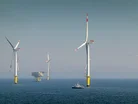Energy Firm Equinor to Build New York Offshore Wind Farm

New York City has granted the construction of a giant offshore wind farm that will generate 9,000 MW of wind power by 2035.
The Empire Wind 1 offshore wind farm will be built by Norwegian energy company Equinor, and is scheduled to start producing power in 2026. Approval for the project was granted in March by the Federal Energy Regulatory Commission.
COWI, the international engineering and consulting group, will also design the wind turbine foundations for the Empire Wind 1 and 2 projects, with the development reaching 80,000 acres and 65-131 feet in water depth.
In light of the Equinor announcement, we take a look at the extremely specialist business of offshore wind farm construction.
How will Empire Wind 1 be built?
Before construction begins, developers perform exhaustive site evaluation and planning work. This involves the use of specialised survey vessels to assess the meteorological conditions, and to carry out wind modelling and environmental impact assessments.
Only after securing seabed leases and the required regulatory approvals from authorities can construction begin.
The first phase of construction is the installation of foundations to anchor the wind turbines. For conventional fixed-bottom wind farms, this means driving large monopile foundations vertically into the seabed using hydraulic hammers on specialised installation vessels. These monopiles can weigh over 1,000 tons apiece, and can extend to over 30 metres below the seabed.
A new, innovative design is the ‘jacket foundation’, comprising a latticed understructure supported by multiple piles. This is used in deeper waters of up to 60 metres. Pile sections and jacket are assembled onshore, and then manoeuvred into position by crane vessels for pile-driving.
For floating wind farms in ultra-deep waters, anchors or mooring systems must be preinstalled on the seabed to secure the floating turbine platforms.
While this work is underway, an offshore substation platform will also be built. This is designed to collect the cables from clusters of turbines and transform the electricity to higher voltages.
Specialised vessels lay lengths of high-voltage cables across the seabed, linking the offshore substation to the onshore grid connection point, while also integrating the inter-array cables between turbine clusters.
But the true magic of offshore wind farm construction is the final installation phase. This is executed by heavy-lift installation vessels, and transition pieces are mounted onto the pre-driven foundations.
The transition piece is a tubular structure made out of high-grade offshore steel, and is connected to the turbine’s foundations. Next, the crane vessel positions the nacelle – a streamlined casing – and the blades. Upon assembly, electrical teams then wire up the turbine using array cables.
Dogger Bank mammoth offshore wind farm
Dogger Bank Wind Farm is currently under construction, and is another project Equinor is involved with – this time in a joint venture with energy company SSE Renewables and Vårgrønn, a Norway-based offshore wind company.
Dogger Bank is a large, shallow sandbank in the North Sea, 100 km off the east coast of England.
The project has a development area of around 599 square metres, and will have an installed generation capacity of 1.2GW (a gigawatt is one billion watts).
Work on Dogger Bank is being undertaken by Aibel, one of Europe’s leading offshore wind, oil and gas installations and onshore processing plants. Aibel is one of the largest suppliers on the Norwegian continental shelf and a full-range supplier of innovative and sustainable solutions. Dogger Bank is also fitted with the latest generation HVDC converter technology by Hitachi Energy, a global technology leader developing sustainable energy.
******
Make sure you check out the latest news at Construction Digital
******
Construction Magazine is a BizClik brand




